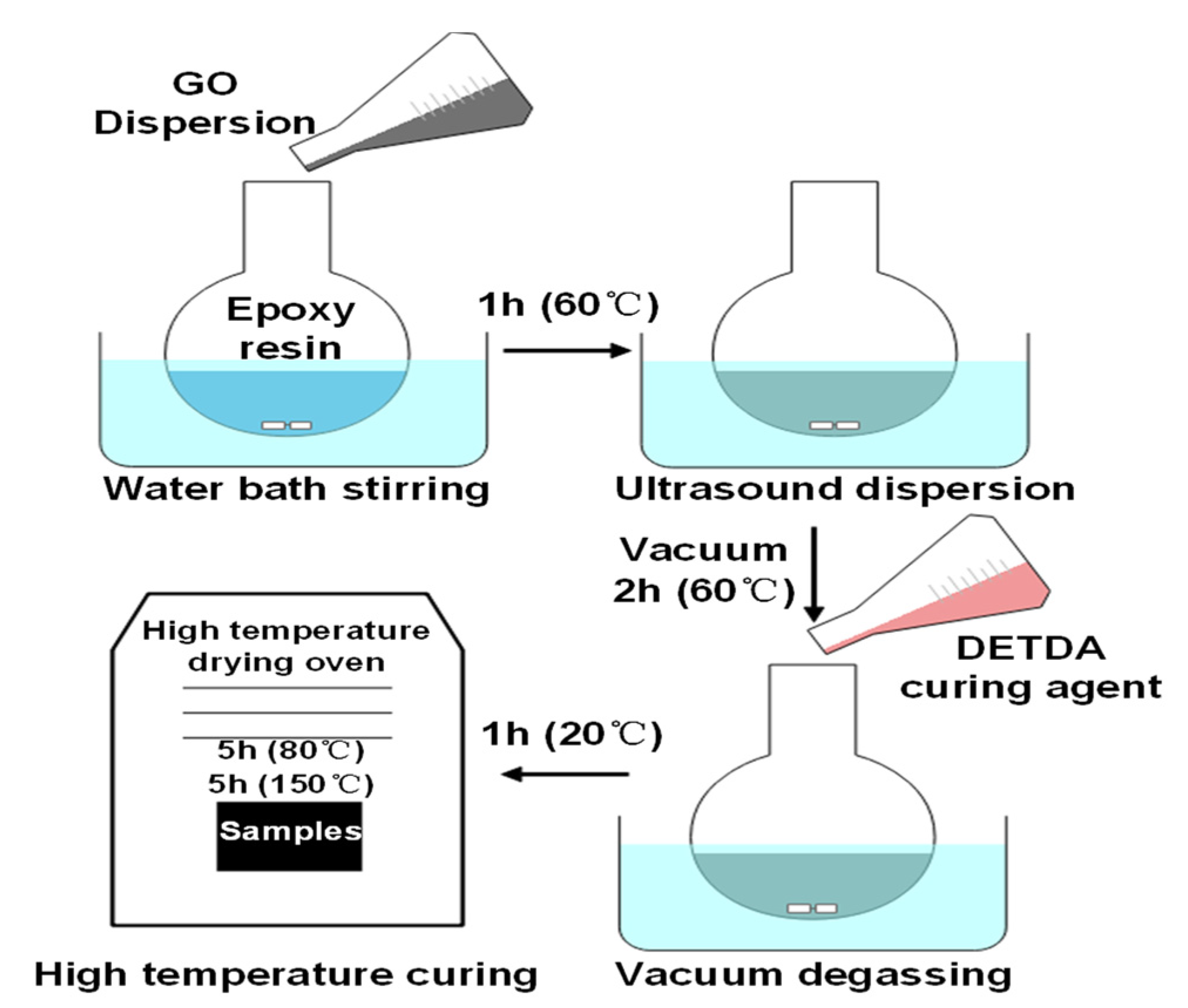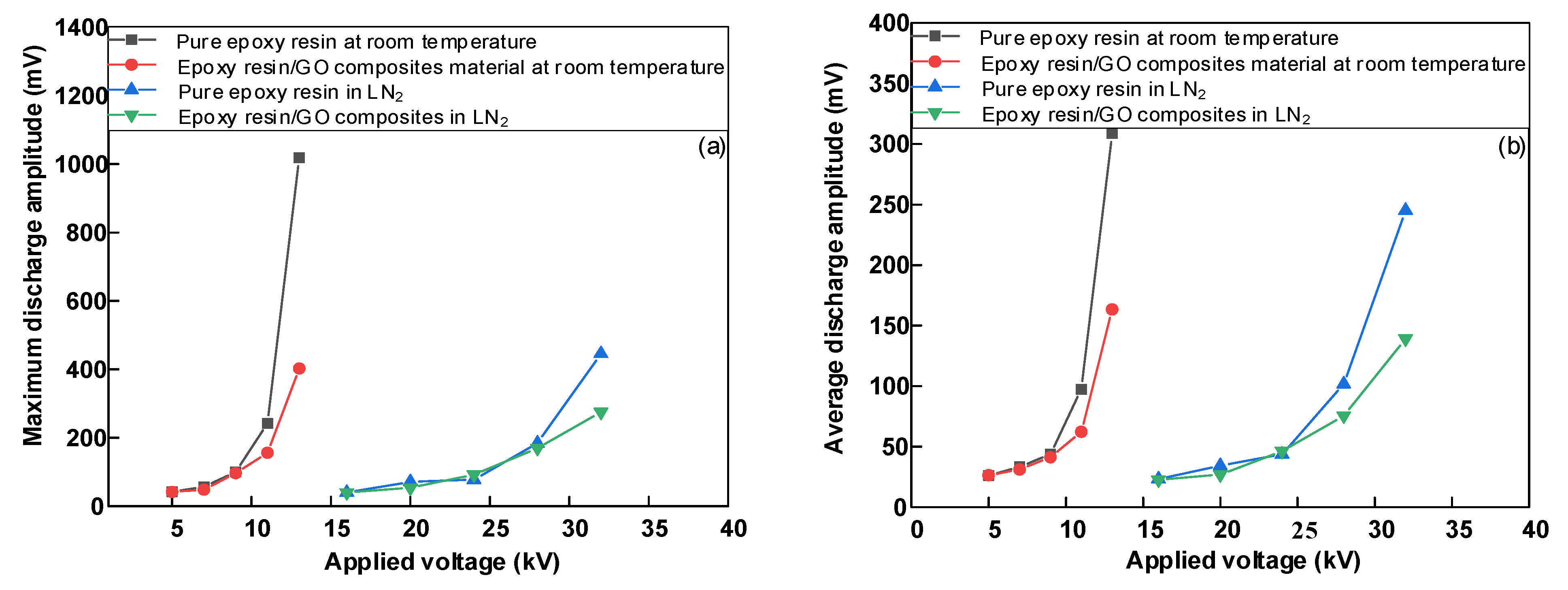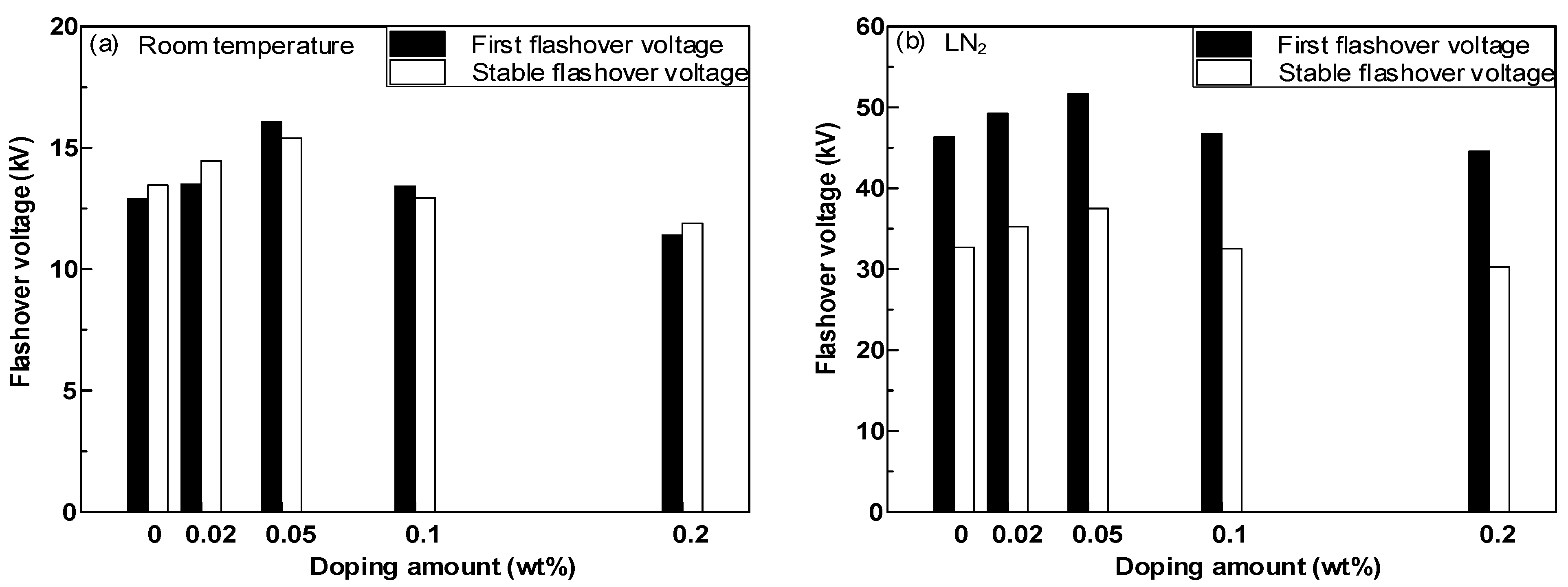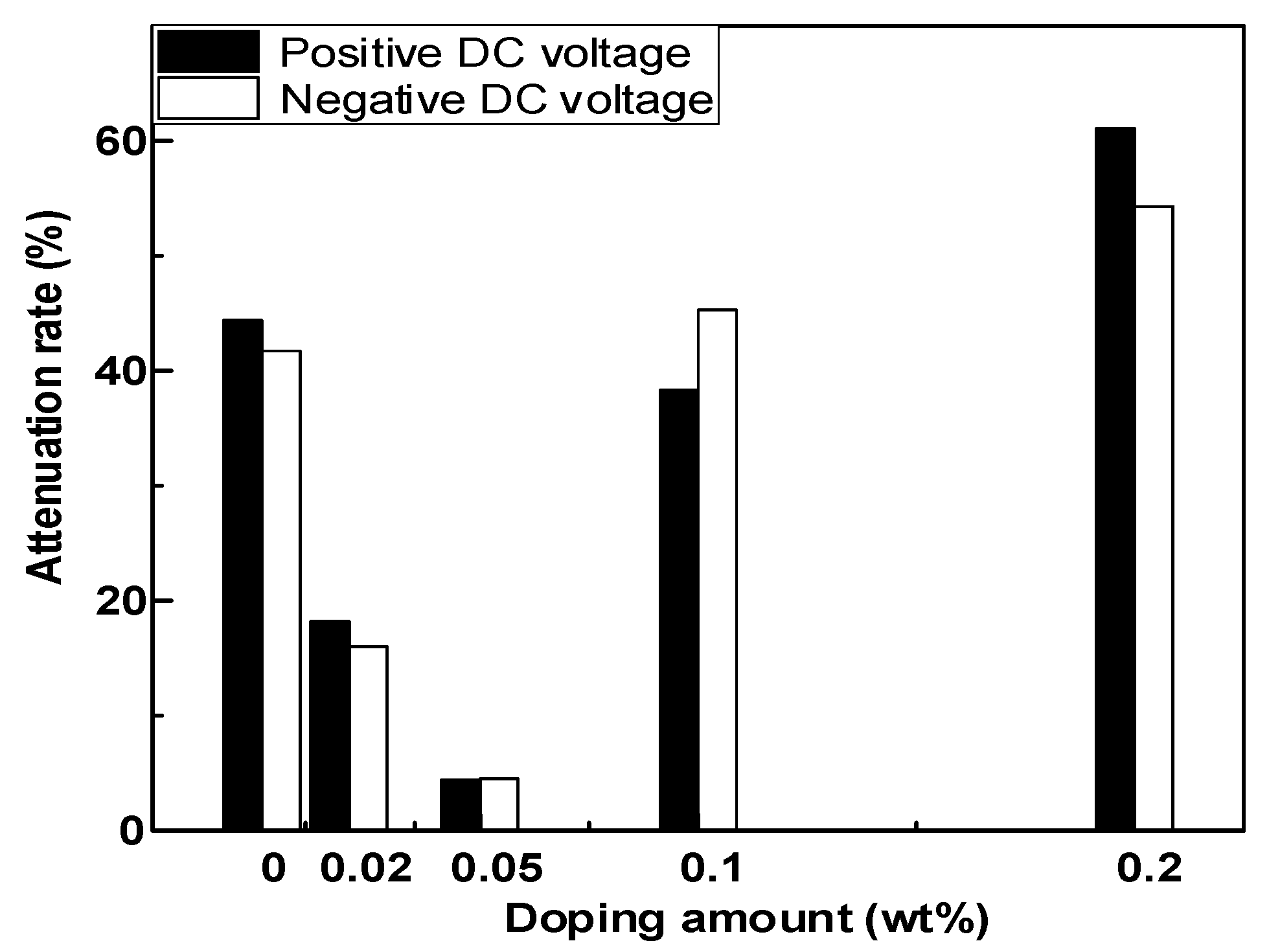Study on Surface Discharge Characteristics of GO-Doped Epoxy Resin–LN2 Composite Insulation
Abstract
:1. Introduction
2. Preparation and Experimental Method of Epoxy Resin Composite Material
2.1. Preparation of Epoxy Resin–GO Composite
- (1)
- Weigh an appropriate amount of bisphenol F epoxy resin into a round bottom flask and place it in a 60 °C water bath to increase the fluidity of the epoxy resin.
- (2)
- Add GO aqueous dispersion into epoxy resin, stir at high speed for 1 h (60 °C), and then conduct ultrasonic treatment for 1 h to increase the dispersion of GO in epoxy resin.
- (3)
- Set the water bath temperature at 60 °C, vacuumize the mixed liquid, and treat the mixed liquid with water for 2 h to remove the water in the mixed liquid.
- (4)
- Add the DETDA curing agent according to the mass ratio of curing agent to epoxy resin of 1:4, stir the mixture at a high speed in a 20 °C water bath, and fully degas it for 1 h.
- (5)
- Pour the mixture into the polytetrafluoroethylene mold, put it into the drying oven, and then pre-solidify it at 80 °C for 5 h and at 150 °C for 5 h.
2.2. Surface Discharge Test Method for Epoxy Resin–GO Composites
3. Dielectric Properties and Surface Discharge Process of Epoxy Resin–GO Composites
3.1. Dielectric Properties of Epoxy Resin–GO Composites
3.2. Surface Discharge Process and Flashover Characteristics of Epoxy Resin–GO Composites
3.3. Analysis of Trap Distribution Characteristics and Surface Discharge Mechanism of Epoxy Resin–GO Composites
4. Discussion
5. Conclusions
- (1)
- Due to the extremely low temperature of LN2 and its strong absorption and barrier effect, the maximum discharge amplitude and discharge repeatability of surface discharge of epoxy composite insulation remain low before critical flashover during the beginning and development of discharge compared with room temperature conditions. When the voltage reaches the critical flashover and the gasification channel is formed, the maximum discharge amplitude and discharge repeatability increase stepwise and rapidly.
- (2)
- Under room temperature and LN2 conditions, the application of nano GO doping modification has an obvious effect on improving the electrical properties of epoxy composite insulation. Under room temperature and LN2 conditions, the flashover voltage of the composites first increases and then decreases, and reaches the highest when the GO doping ratio is 0.05 wt%. In addition, the flashover voltage at room temperature has no obvious relationship with the number of flashover, but the first flashover voltage of epoxy composite insulation under LN2 is significantly higher than that of subsequent flashover voltage.
- (3)
- Under the condition of LN2, the development of surface discharge and the flashover process on epoxy composite insulating material are closely related to the formation of desorbed gas and the gasification layer on the material surface. Electron emission is suppressed and discharge develops slowly before the formation of a gas layer, penetrating the anode. Once the penetrating gasification layer is formed, the surface discharge can develop rapidly and flashover breakdown can quickly occur.
Author Contributions
Funding
Data Availability Statement
Conflicts of Interest
References
- Liu, Z.T.; Li, Y.G. Development path of China’s gas power industry under the background of low-carbon transformation. Nat. Gas Ind. 2021, 41, 152–161. [Google Scholar] [CrossRef]
- National Bureau of Statistics. Statistical Bulletin of the People’s Republic of China on National Economic and Social Development in 2019; National Bureau of Statistics: Beijing, China, 2020.
- Zhou, X.Q. Development, planning and implementation of the project of power transmission from west China to east China. Power Syst. Technol. 2003, 27, 1–5. [Google Scholar]
- Hong, H.; Chen, Z.F. The present status of HTS DC cable. Cryog. Supercond. 2012, 40, 58–63. [Google Scholar]
- Qiu, Q.Q.; Chen, Z.F. Development Status and Trend of Superconducting DC Power Transmission Technology. S. Power Syst. Technol. 2015, 9, 11–16. [Google Scholar]
- Yu, L.J.; Wang, Y.S. Design of ±100 kV/1 kA bipolar DC HTS cable conductor of energy pipe. Cryog. Supercond. 2020, 48, 37–43. [Google Scholar]
- Zhou, Z.L. Energy efficiency analysis of hydrogen storage coupled Gas-Steam combined cycle. Acta Energ. Sol. Sin. 2021, 42, 39–45. [Google Scholar]
- Zhang, J.; Qiu, M. Research status and key technologies of hybrid energy transfer line. Cryog. Supercond. 2021, 49, 1–7. [Google Scholar]
- Fichera, C.; Bertarelli, A. New methodology to derive the mechanical behavior of epoxy-impregnated Nb3Sn cables. IEEE Trans. Appl. Supercon. 2019, 29, 1–12. [Google Scholar] [CrossRef]
- Memduh, K.; Muhammed, K. Impact behavior of carbon fiber/epoxy composite tubes reinforced with multi-walled carbon nanotubes at cryogenic environment. Compos. B Eng. 2018, 145, 145–154. [Google Scholar] [CrossRef]
- Feng, X.; Tong, Q.B. Reasearch progress in nonlinear polymer composites for superconducting cable terminal. Insul. Mater. 2017, 50, 10–14. [Google Scholar]
- Torabizadeh, M.A. Tensile, compressive and shear properties of unidirectional glass/epoxy composites subjected to mechanical loading and low temperature services. Indian J. Eng. Mater. Sci. 2013, 20, 299–309. [Google Scholar]
- Yang, X.; Guo, Y.Y. Impulse surface flashover characteristics of G/R and PTFE in Liquid Nitrogen. High Volt. Eng. 2015, 41, 654–661. [Google Scholar] [CrossRef]
- Sun, H.; Dai, S.T. The electrical insulation characteristics for a HSFCL termination. Cryog. Supercond. 2015, 43, 1–5. [Google Scholar]
- Tu, Y.P.; Zhou, F.W. Effect of nano-TiO2/EP composite coating on dynamic characteristics of surface charge in Epoxy Resin. IEEE Trans. Dielectr. Electr. Insul 2018, 25, 1308–1317. [Google Scholar] [CrossRef]
- Xiao, M.; Li, Q.Q. Surface insulation breakdown behaviors in Liquid Nitrogen environment of Epoxy/BN composite. IEEE Trans. Appl. Supercon. 2016, 26, 1–4. [Google Scholar] [CrossRef]
- Tan, R.; Xie, L. Study on DC insulation properties of glass fiber reinforced epoxy resin at different temperatures. Cryog. Supercond. 2020, 48, 37–43. [Google Scholar]
- Zeng, Y.; Miao, G.C. Study on LD-144 modified aluminum nitride/epoxy resin thermal conductive composite. N. Chem. Mater. 2016, 44, 40–42. [Google Scholar]
- Lee, Y.J.; Shin, W.J. High voltage dielectric characteristics of epoxy nano-composites in Liquid Nitrogen for superconducting equipment. IEEE T. Appl. Supercon. 2011, 21, 1426–1429. [Google Scholar] [CrossRef]
- Koo, J.H.; Hwang, J.S. Comparison of DC and AC surface breakdown characteristics of GFRP and Epoxy nanocomposites in Liquid Nitrogen. IEEE T. Appl. Supercon. 2016, 26, 1–4. [Google Scholar] [CrossRef]
- Zhang, B.Y.; Zhang, G.X. Interpretation of the surface charge decay kinetics on insulators with different neutralization mechanisms. J. Appl. Phys. 2017, 121, 105105. [Google Scholar] [CrossRef]
- Du, B.X.; Kong, X.X. Trap distribution of electron beam irradiated epoxy resin under repetitive pulse voltage. IEEE Trans. Dielectr. Electr. Insul. 2017, 24, 3869–3877. [Google Scholar] [CrossRef]
- Gao, Y.; Wang, X.F. Characterization method for carrier trap and the effect on insulation breakdown within polymer insulating materials: A Review. High Volt. Eng. 2019, 45, 2219–2230. [Google Scholar]












Publisher’s Note: MDPI stays neutral with regard to jurisdictional claims in published maps and institutional affiliations. |
© 2022 by the authors. Licensee MDPI, Basel, Switzerland. This article is an open access article distributed under the terms and conditions of the Creative Commons Attribution (CC BY) license (https://creativecommons.org/licenses/by/4.0/).
Share and Cite
Xing, Y.; Chen, Y.; Yuan, R.; Yang, Z.; Yao, T.; Li, J.; Zhu, W.; Wang, X. Study on Surface Discharge Characteristics of GO-Doped Epoxy Resin–LN2 Composite Insulation. Polymers 2022, 14, 1432. https://doi.org/10.3390/polym14071432
Xing Y, Chen Y, Yuan R, Yang Z, Yao T, Li J, Zhu W, Wang X. Study on Surface Discharge Characteristics of GO-Doped Epoxy Resin–LN2 Composite Insulation. Polymers. 2022; 14(7):1432. https://doi.org/10.3390/polym14071432
Chicago/Turabian StyleXing, Yunqi, Yuanyuan Chen, Ruiyi Yuan, Zhuoran Yang, Tianyi Yao, Jiehua Li, Wenbo Zhu, and Xiaoxue Wang. 2022. "Study on Surface Discharge Characteristics of GO-Doped Epoxy Resin–LN2 Composite Insulation" Polymers 14, no. 7: 1432. https://doi.org/10.3390/polym14071432
APA StyleXing, Y., Chen, Y., Yuan, R., Yang, Z., Yao, T., Li, J., Zhu, W., & Wang, X. (2022). Study on Surface Discharge Characteristics of GO-Doped Epoxy Resin–LN2 Composite Insulation. Polymers, 14(7), 1432. https://doi.org/10.3390/polym14071432





